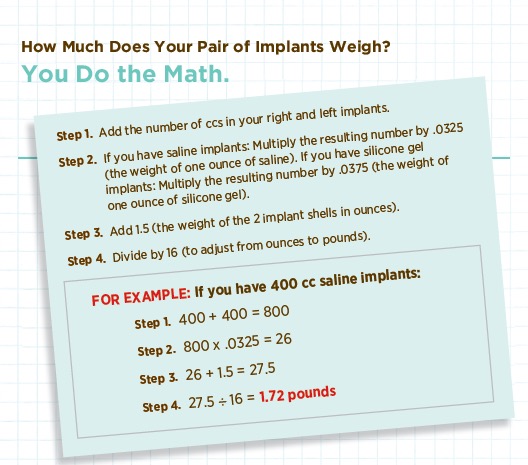Breast Implant Statistics – Dr. Ted Eisenberg
Breast Implants By the Numbers
1. In 2018, about 1.8 million women around the world had breast augmentation surgery with saline or silicone breast implants. Some 300,000 of them lived in the United States, according to the International Society of Aesthetic Plastic Surgery. Some of those implants were placed as part of augmentation mastopexy surgery, also known as a breast lift with implants.
2. Breast implants are measured in cubic centimeters (ccs) rather than cup size. To figure out how many ounces the implants are, divide the number of cubic centimeters in each of them by 30.
 3. On a woman who is completely flat-chested and has a medium-sized frame, a 450 cc implant would be equivalent to the average C-cup bra. 450 ccs equals about 15 ounces, like this water bottle.
3. On a woman who is completely flat-chested and has a medium-sized frame, a 450 cc implant would be equivalent to the average C-cup bra. 450 ccs equals about 15 ounces, like this water bottle.
4. Don’t fret over a few cc difference in implant size: The difference between a 375 cc and a 400 cc implant is less than 2 tablespoons – the amount of oil you would add to boxed pancake mix.
 5. The largest standard saline implant is 775 ccs, while a silicone gel implant is 800 ccs. That’s equivalent to about 27 ounces, like this can of salsa.
5. The largest standard saline implant is 775 ccs, while a silicone gel implant is 800 ccs. That’s equivalent to about 27 ounces, like this can of salsa.
6. It’s rare for a surgeon to charge more for a breast augmentation with larger-sized implants. Manufacturers don’t charge by the cubic centimeter either: They charge one set price for all off-the-shelf saline breast implants, whether they are 200 ccs or 600 ccs, and another set price (about $1,000 higher) for silicone gel implants.
7. If you get a pair of 350 cc saline implants, they’ll weigh about 1.5 pounds. If you get a silicone gel set, they’ll be closer to 1.7 pounds. To calculate how much your implants weigh, see below:
Wouldn’t math class have been a lot more fun if you had problems like these to solve?
8. Although your main focus might be on the size of your breast implants, Dr. Ted Eisenberg has much more to evaluate at your consultation, including your skin elasticity, your breast diameter (the distance from 3 o’clock to 9 o’clock on each breast), the distance from the nipple to the crease under the breast (the amount of droop), your body type (small, medium or large-boned), and your height and weight.
9. What’s the right size for an areola? The judgment around size is personal and cultural. Areola size doesn’t necessarily correspond to breast size. Some women have smaller breasts and larger areolas; others have larger breasts and smaller areolas. During breast reduction surgery, the areola is often reduced to 38 to 42 mm in width (about 1-1/2 inches).
10. For saline breast implants, the incision averages 1-1/2 inches long; for silicone gel breast implants it’s closer to 2 inches. Silicone implants are prefilled, so the surgeon needs to make a larger opening to insert them into the space. By contrast, saline implants come empty and can be folded up and inserted through a smaller incision.
11. Breast implants are designed to be sturdy, and each manufacturer has its own testing protocol. Allergan tests its implants by exerting nearly 55 pounds of force on them repeatedly, up to 6.5 million times. By contrast, a routine mammogram exerts about 40 pounds of force when it compresses the breast, and if a woman had 50 mammograms in her lifetime, it would be a lot. [WATCH OUR VIDEO: Can a Mammogram Break a Breast Implant?]
12. Bonus Fact: The TSA says that liquids and gels are safe to bring aboard an aircraft in limited amounts – 3.4 ounces or less. Thank goodness breast implants are “packed in your luggage,” so to speak, because one 425 cc implant is equal to about 14 ounces. It would be hard to squeeze it into one of those quart-sized plastic bags.
Busting Some Breast Implant Myths
Do breast implants freeze up in really cold weather?
Outside of the body, a saline implant would freeze at about 28 degrees Fahrenheit, while a silicone gel implant would ice up at around 170 degrees below zero. Because your breast implants are close to your body, your natural body heat will keep them warm.
If you have some time on your hands, check out The Measure of Things, where you’ll learn lots of “useful” facts including that 450 ccs is about 20 times as big as a marshmallow!
Will breast implants melt in a sauna?
All breast implants have a silicone shell, and that would only melt at temperatures greater than 392 degrees Fahrenheit. A conventional sauna is typically between 150 and 190 degrees. If you were in an environment where your breast implants would melt, you’d melt, too.
Is it true that breast implants can explode at 35,000 feet?
No, but it didn’t stop Spike TV from saying so. An episode of 1000 Ways to Die, titled “Titty Titty, Bang Bang,” showed a woman who exploded on a flight to Las Vegas when the liquid in her implants expanded. If this were true, wouldn’t many Hollywood actresses have exploded by now?
MythBusters, a more scientifically sound television program, had busted that myth years earlier. Their research team put implants in a hypobaric chamber, recreated the altitude at 35,000 feet, and observed that the implants expanded insignificantly. Other researchers took breast implants on a simulated trip from the bottom of the ocean to the top of Mount Everest, and the implants still didn’t burst. This means that if you went to 35,000 feet in an unpressurized airplane, your implants would be safe. Unfortunately, you would be dead in about 10 minutes from hypoxia (oxygen deficiency).





 CLICK HERE TO BUY
CLICK HERE TO BUY







